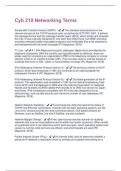Exam (elaborations)
Cyb 210 Networking Terms Questions and Answers Latest Update 100% Correct.
- Course
- Institution
Simple Mail Transfer Protocol (SMTP) - ️️The standard email protocol on the internet and part of the TCP/IP protocol suite, as defined by IETF RFC 2821. It defines the message format and the message transfer agent (MTA), which stores and forwards the mail. It was originally designed for only...
[Show more]



